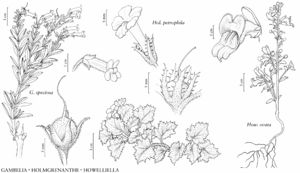Holmgrenanthe petrophila
Syst. Bot. Monogr. 5: 54. 1985.
Plants 5–12 cm, cespitose. Stems brittle. Leaves: petiole 12–27 mm; blade orbiculate to reniform, 12–35 × 14–27 mm, apex spinulose. Pedicels ascending, 1–4 mm, glandular-puberulent to glandular-villous. Flowers: sepals falcate, 9–13 × 2–3 mm, margins spinulose, glandular-villous; corolla tube 20–24 mm, glandular-villous, throat open, palate not inflated, abaxial plicae dark yellow with ligulate hairs; lobes: abaxial projecting, adaxial erect, equal, rounded, 7–12 mm; stamens included, filaments incurved, yellow at base, abaxial 12–14 mm, adaxial 7–9 mm, pollen sacs oblong; ovary with a T-shaped septum; style included, terete, 9–10 mm, stigma recurved. Capsules globular, 8–10 mm. Seeds 2–3 mm, surface foveolate.
Phenology: Flowering Apr–Jun.
Habitat: Calcareous canyon walls.
Elevation: 700–1800 m.
Discussion
Holmgrenanthe petrophila is known from the limestone walls of Fall and Titus canyons in the Grapevine Mountains in Death Valley National Monument, Inyo County.
Selected References
None.
